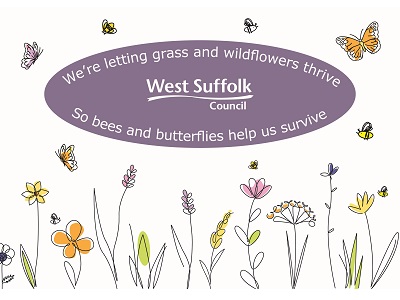Micro areas of biodiversity encouraged to help the environment
29 Jun 2023

Micro areas of biodiversity are being encouraged around West Suffolk as part of the West Suffolk Council’s wider policy on reducing the use of weedkiller and encouraging plant and insect life.
Residents will see the council has left areas that would have previously been sprayed with weedkiller around vertical features in grassed areas such as trees, signs, and lamp columns. Before these would have been treated with glyphosate but have now been left to grow.
Although they will be strimmed later in the growing season, these small areas, (which look a little less tidy than before, with a halo of growth) will support biodiversity such as vital pollinators.
This is in addition to the larger areas that are deliberately left uncut or have pathways created through them to support the environment. These spaces are cut less frequently with the grass being taken for hay or managed for wildflowers to support important pollinators
However the council does regularly cut other areas, such as playing areas and where residents have asked, and where safety is an issue such as some verges.
This approach to grass cutting keeps areas the council manages safe and in use, while at the same time allowing wildlife to thrive.
The council maintains a total area of 308 Ha (761 acres) of amenity grass, which amounts to just over 1,000 football pitches. Of this, around a quarter is classified as highway verge. These areas comprise thousands of disparate plots of land across the entire district.
The council cuts the areas of amenity grass it is responsible for on a three week cycle, full details of which are available on the council website Grass cutting
Cllr Ian Shipp, Cabinet Member for Leisure, said: “We know that grass cutting is important to our residents and views differ from we are not doing enough to we are doing too much. Finding a balance can be a challenge, but through a range of measures and management techniques, we are working to ensure we find the right balance between safety, tidiness and allowing wildflowers to flourish. Even small areas around posts and poles that are being left and not treated with weedkiller may look untidy but provide essential habitats.
"Our grass cutting approach has been designed to provide a good balance to keep our green spaces safe and tidy, while at the same time giving wildflowers an opportunity to thrive. We regularly review our grounds maintenance to make improvements, and act on feedback from our local communities about their area.
“If there is an area you would like us to consider managing for better biodiversity, please let us know using the form on our website Grounds maintenance enquiry form.
“You can also find has mapping for all the areas we manage on the website Find my nearest easily searchable by your postcode. The type of land use shown determines the frequency of cut. Amenity land, shown in plain green, is cut most frequently and you can look up when it is due to be cut in the weekly lists Grass cutting published from April to October.”
Other agencies, such as Suffolk County Council, The Highways Agency or housing organisations are responsible for other areas of grass cutting and management of vegetation on their land.
Posted in categories: press release, news, environmental-news
